As I said, there are a very few flowers that bloom in our yard during May. This is more than I knew two months ago. That they would all bloom before October was about as specific as I dared to get. There are expected bloom times for any species, normally given as a range of dates that are dependent on climate conditions. Furthermore, microclimates matter. I've recently strolled past southern-exposed gardens which sport open flowers of the same kind as mine which are still tightly closed, cringing against their harsh western exposure. Well, it's not a race.
 |
| Pasque Flower (Pulsatilla) |
After the demise of crocuses and glories-of-the-snow in April, Pasque flower was the first bloom in May, just a little later than the closely related prairie crocuses that grow in the coulees. The plant was purchased two (?) years ago and grows inches from the sidewalk. Although it will never bloom early enough in Lethbridge, it's flowers have the colours of Easter - deep purple petals with a ring of bright yellow thingies around a pointy bit in the center. (Should I, perhaps, learn the proper names of flower parts?) Even better, the leaves and stems are furry. This is a plant you can pet. The blooming has gone on for about four weeks now; the first flowers are now spectacular spiky seed heads (picture needed here). It puts on a good show. About a week ago I noticed what appeared to be a flower stalk coming to an abrupt end about three inches up. Thief!, I gasped, but soon forgave. The plants are there to be enjoyed by the passing public. Maybe somebody liked it so much she just had to take it, maybe even to the plant store so she could get one of her own. Maybe someone took it to his sick father. We live between two hospitals. I'm glad it was that special to somebody.
 |
| Elephant Ears (Bergenia) |
Elephant ears live in the same triangular garden as the Pasque flower and are one of the reasons I think of this area as a zoo. There are five other animals mentioned in names of plants located here, six if "baby" counts as an animal. This plant was one of the original residents of this plot, having been installed in 2008 when the lawn was torn out. The flowers are new, though. Sometimes it takes a while. It seems they want to invest in roots first before diversifying into blossoms. Or could be some other reason. Anyway, it erected two robust red stalks and hung out some little pink blossoms of the ends of them. Not my favourite colour combination, red and pink, yet I don't think any less of the elephant ears for it. Plants get away with a lot.
 |
| Cranesbill (Geranium) |
Another of the critter-inspired names here is cranesbill geranium, and I have not figured out which part of the blossom resembles the bill of a crane. If I were naming this organism after an animal, I think I'd choose a winged insect because of the fine, dark veins of the petal, so distinct against the pale background. This individual, introduced to the garden late last summer, opened it's first blossom of the season on the last day of May, just making it into this post. Today there are two more open and one getting ready.
 |
| Chives (Allium) |
The under-rated chive flower appears to be mainly a June baby in our back yard, but since a few (of the hundreds that will be) burst through their casings in the last couple of days, they count as May flowers. Didn't I post a photo of emerging chive flowers back on April 3? They take their time. The chive cluster is a lovely patch of green, and increasing pink, in the middle of the garden. Now that the flowers are opening, it will be a hub of activity for the local bees. It's been a welcome surprise, discovering that seeds I planted six years ago for a season of herbs became this beautiful edible perennial bee magnet. Why doesn't everyone grow masses of chives? Could it be the prodigious self-seeding? Yes, we have a great cluster of grown-up chives, and a two foot border of baby chives all around it. It's good to know that onion family plants are good companions to a great number of the other vegetables we grow.





No comments:
Post a Comment